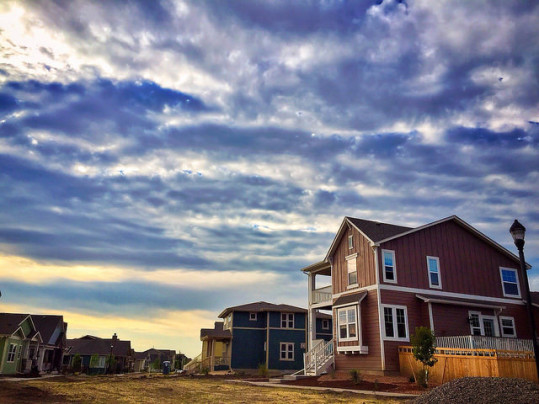When an offer to buy a house is accepted, a contract is signed. After that, the home’s sale is considered pending until the buying process is completed and all of the paperwork is done. Because contract signings precede closings, pending sales can be a good indicator of future home sales. That’s why the National Association of Realtors measures them on a monthly basis. In July, their Pending Home Sales report shows contract signings were down from the month before but remain virtually unchanged from where they were last year at the same time. Lawrence Yun, NAR’s chief economist, says there are a couple of reasons favorable conditions have yet to result in increasing sales. “Super-low mortgage rates have not yet consistently pulled buyers back into the market,” Yun said. “Economic uncertainty is no doubt holding back some potential demand, but what is desperately needed is more supply of moderately priced homes.” Yun believes that an increase in new home construction is necessary to help boost, not just the housing market and home sales, but the overall economy as well. More here.
Archive for August 2019
Rate Increase Is First In More Than A Month
According to the Mortgage Bankers Association’s Weekly Applications Survey, average mortgage rates were up last week, marking the first increase in more than a month. Rates rose for 30-year fixed-rate mortgages with both conforming and jumbo balances, while loans backed by the Federal Housing Administration saw the only week-over-week decline. Joel Kan, MBA’s associate vice president of economic and industry forecasting, said mortgage rates haven’t held much sway with summer buyers one way or the other. “Purchase applications were still up around 2 percent year-over-year, but the drop in rates this summer has not yet led to a significant boost in activity,” Kan said. “Uncertainty over the near-term economic outlook and low supply continue to be the predominant headwinds for prospective home buyers.” Also in the report, refinance activity fell after surging in recent weeks. Increasing rates caused an 8 percent decline from the week before. Despite the drop, however, refinance demand is now 167 percent higher than at the same time last year. The MBA’s weekly survey has been conducted since 1990 and covers 75 percent of all retail residential mortgage applications. More here.
Have Home Prices Finally Leveled Off?
Home prices have been rising for years now. But, according to new data, they may be finally starting to level off. The numbers, from S&P CoreLogic Case-Shiller Indices – which is considered to be the leading measure of U.S. home prices – shows price increases have continued to slow. Nationally, S&P’s most recent reading has them up just 3.1 percent year-over-year. Philip Murphy, managing director and global head of index governance at S&P Dow Jones Indices, says that may be a sustainable level. “Home price gains continue to trend down, but may be leveling off to a sustainable level,” Murphy said. “While housing has clearly cooled off from 2018, home price gains in most cities remain positive in low single digits. Therefore, it is likely that current rates of change will generally be sustained barring an economic downturn.” And though prices are still rising, a 3 percent year-over-year increase is actually below normal. In fact, according to an analysis from the National Association of Realtors, the average yearly increase from 1968 through 2004 was 6.4 percent. More here.
The Number Of Vacant Properties Has Plummeted
When the housing market crashed and home prices fell, many homeowners found themselves underwater. The subsequent crisis meant hundreds of thousands of homeowners owed more on their mortgage than their homes were worth. That caused the number of foreclosures, vacancies, and abandoned properties to spike. Fortunately, though, home prices began to rebound in 2012 and helped reverse those losses. Now, after many years of increasing home values, a new report from ATTOM Data Solutions shows just how significant that reversal has been. According to their Q3 2019 Vacant Property and Zombie Foreclosure Report, there are currently 1.5 million vacant single-family homes and condos in the country. That represents just 1.6 percent of all homes. Todd Teta, ATTOM’s chief product officer, says that’s a dramatic improvement. “The blight of vacant, decaying properties facing foreclosure has declined dramatically across the United States – another good-news offshoot of the housing boom that’s gone on for eight years,” Teta said. “A handful of areas still face notable problems with homes abandoned by owners after they get hit with foreclosure claims. But with the economy improving and the housing market still hot, an expanding number of neighborhoods across the country face little or no problem with these so-called zombie properties.” More here.
New Home Market Shows Signs Of Momentum
The latest data from the U.S Census Bureau and the Department of Housing and Urban Development shows new home sales down nearly 13 percent in July. But the decreasing sales numbers are a bit misleading. That’s because the decline was mostly the result of a significant revision to month-before numbers. New home sales data is an estimate based on building permits and is often revised after initial reporting. In this case, after being revised upward, the June data actually shows sales were at their fastest pace since 2007. And, even after declining in July, sales of newly built homes remain 4.3 percent higher than at the same time last year. That’s encouraging news for the market. Combined with increased residential construction and moderating prices, the improvement could be a sign that the housing market is gaining some momentum. One possible reason for the positive turn is lower mortgage rates. Another is lower prices. According to the report, the median sales price of new homes sold in July fell 4.5 percent. Additionally, inventory levels improved, with the supply of homes rising to 337,000 units. At the current sales rate, that’s a 6.4-month supply. More here.
Typical Home On The Market For 29 Days In July
If you’re thinking about buying a house sometime soon, you should be prepared to act fast. New numbers from the National Association of Realtors show that the typical property was on the market just 29 days in July. And, while that’s up from the month before and better than last year at the same time, it still means good homes are selling quickly. In fact, 51 percent of homes sold in July were on the market less than a month. Lawrence Yun, NAR’s chief economist, says the market is suffering from a lack of lower-priced homes for sale. “Clearly, the inventory of moderately-priced homes is inadequate and more home building is needed,“ Yun said. “Some new apartments could be converted into condominiums thereby helping with the supply.” But despite low inventory, home sales rose in July, climbing 2.5 percent over the month before. Regionally, sales fell in the Northeast but improved in the Midwest and South. In the West, home sales were up 8.3 percent from the month before. More here.
Will Low Mortgage Rates Spur A Buying Boom?
According to the Mortgage Bankers Association’s Weekly Applications Survey, average mortgage rates fell last week for 30-year fixed-rate mortgages with conforming loan balances. But the drop, which has rates hovering just above record lows, failed to move home buyers. In fact, demand for loans to buy homes fell from the week before. So why haven’t favorable rates spurred a buying boom? Well, though low mortgage rates are good for buyers and help ease affordability conditions, they aren’t the only factor affecting how many buyers are active in the market. For example, high home prices and a lack of affordable homes for sale are currently playing a role in limiting sales. Also, demand for purchase loans isn’t as responsive to mortgage rate fluctuations as refinance activity – which is now at a three-year high. But though purchase demand fell last week, it still remains 5 percent higher than one year ago, indicating a lot of interest from buyers as the summer season winds down. The MBA’s weekly survey has been conducted since 1990 and covers 75 percent of all retail residential mortgage applications. More here.







